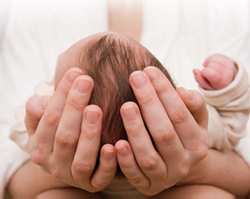Getting back to Normal

For the first week after delivery try to rest whenever you can. Don’t be tempted to try to catch up on everything you have not had the time to do. Call your doctor if you have any problems before your postpartum check-up. You may be rather disheartened when you see your body after birth. Your stomach won’t be flat, your breasts will be large, and the tops of your legs will feel heavy. But if you practice your postnatal exercises as soon as possible after birth, you will begin to look and feel better.
How you will feel
As the initial rush of excitement of your baby’s birth settles down, you will probably experience some discomfort, and even pain, in the first days. Ask the doctor or midwife if anything worries you.
After pains
You may feel cramping pains in your stomach, especially when breastfeeding, as the womb contracts back to its pre-pregnant size. This is a good sign that your body is returning to normal. The pains may last several days.
What to do
If contractions are severe, a mild painkiller such as acetaminophen or ibuprofen may ease them.
Bladder
It’s normal to urinate more often in the first days, as the body loses the extra fluid gained in pregnancy.
What to do
Urinating may be difficult at first because of soreness, but try to do so as soon as possible after birth.
• Get up and about to encourage the urinary flow.
• Soak in a warm bath. Don’t worry if you pass urine into the water as urine is sterile; wash yourself well afterwards.
• If you have stitches, try pouring warm water over them as you pass urine to stop your skin stinging.
Bleeding
You may have vaginal bleeding for anything from two to six weeks. This usually stops more quickly if you are breastfeeding. The bright-red discharge is heavy at first, but over the next few days it decreases and gradually becomes brownish. Often the discharge continues until the first menstrual period.
What to do
Wear sanitary pads to catch the flow; don’t use internal tampons, because they may be uncomfortable.
Bowels
You may not need to empty your bowels for a day or more after the birth.
What to do
Get mobile as soon as possible: this will start your bowels working.
• Drink plenty of water and eat high-fibre foods to stimulate your bowels.
• When you want to empty your bowels, do so at once, but don’t strain too hard.
• It is most unlikely that any stitches will tear when you move your bowels, but holding a clean sanitary pad against the area while you do so may help you feel more confident.
Stitches
These may be very sore for a few days. Most dissolve in about a week.
What to do
The following suggestions will help the recovery process.
• Practise pelvic floor exercises as soon as possible after birth to speed up healing.
• Keep the stitches clean by relaxing in a warm bath. Dry the entire area thoroughly afterwards.
• Soothe soreness by applying an ice-pack to the area.
• Lie down to take pressure off the stitches, or sit on a rubber ring.
Coping with the blues
Many women feel low a few days after delivery, usually when the milk comes in. One cause is the sudden change in hormone levels, another is the feeling of anti-climax that sometimes occurs after birth. These postpartum blues usually vanish. If you feel depressed for more than four weeks, or your depression is severe, see your doctor immediately.
Thinking positively
The sheer pleasure and delight of finally having your newborn baby will probably more than compensate for the after effects of the labour and birth process.
 Excerpted from CMA Complete Book of Mother & Baby Care Copyright © 2011 by DK Publishing. Excerpted by permission DK Publishing. All rights reserved. No part of this excerpt may be reproduced or reprinted without permission in writing from the publisher. Buy the book!
Excerpted from CMA Complete Book of Mother & Baby Care Copyright © 2011 by DK Publishing. Excerpted by permission DK Publishing. All rights reserved. No part of this excerpt may be reproduced or reprinted without permission in writing from the publisher. Buy the book!





